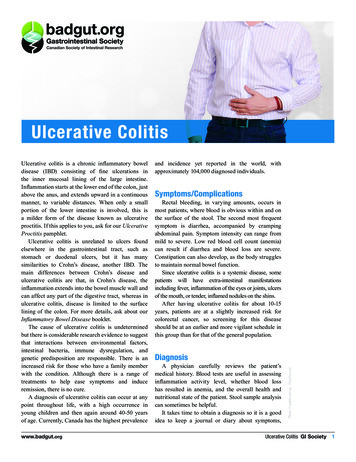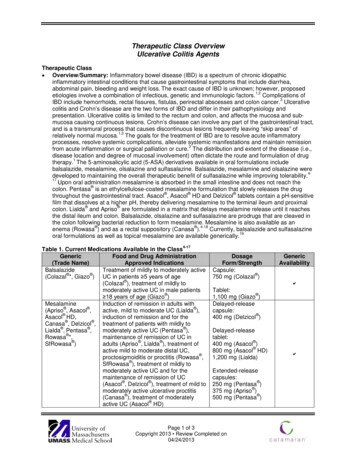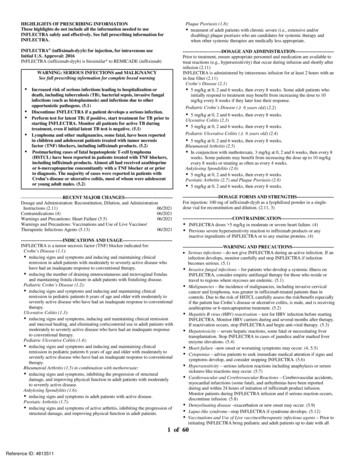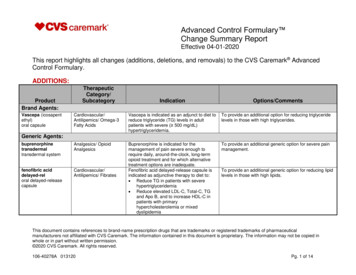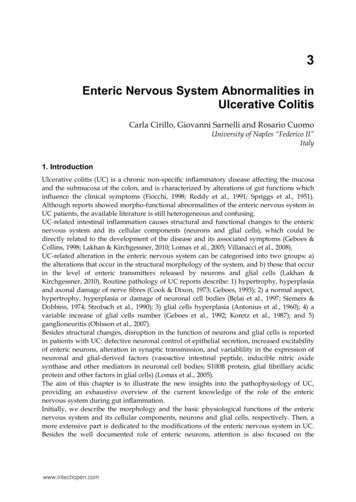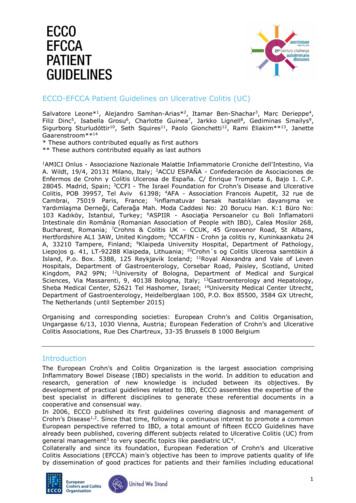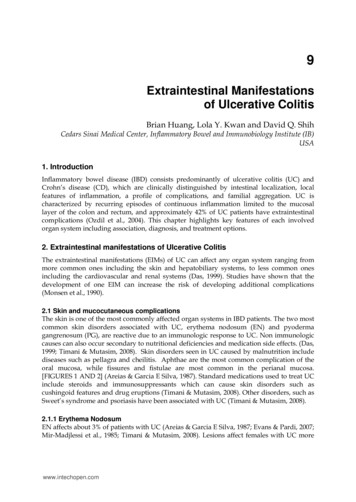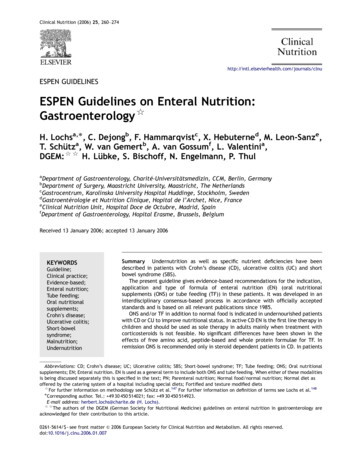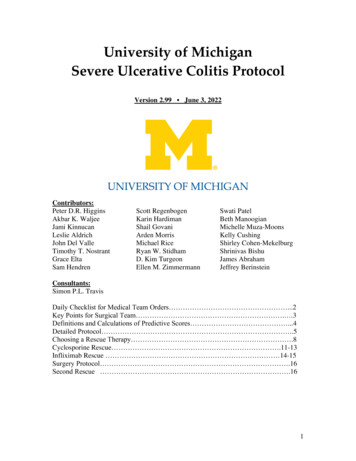
Transcription
University of MichiganSevere Ulcerative Colitis ProtocolVersion 2.99 June 3, 2022Contributors:Peter D.R. HigginsAkbar K. WaljeeJami KinnucanLeslie AldrichJohn Del ValleTimothy T. NostrantGrace EltaSam HendrenScott RegenbogenKarin HardimanShail GovaniArden MorrisMichael RiceRyan W. StidhamD. Kim TurgeonEllen M. ZimmermannSwati PatelBeth ManoogianMichelle Muza-MoonsKelly CushingShirley Cohen-MekelburgShrinivas BishuJames AbrahamJeffrey BerinsteinConsultants:Simon P.L. TravisDaily Checklist for Medical Team Orders .2Key Points for Surgical Team . .3Definitions and Calculations of Predictive Scores .4Detailed Protocol .5Choosing a Rescue Therapy .8Cyclosporine Rescue .11-13Infliximab Rescue 14-15Surgery Protocol .16Second Rescue .161
Daily Checklist for Medical Team OrdersDayStudiesAdmission/D1 Comp, pre-albumin, CBCPD, ESR, CRP, Total Cholesterol,TPMT enzyme activity*, Quantiferon**, Abdominal film, C diff,CMV PCR, GI PCR, Hepatitis serologies for Hep A, Hep BsAb,BsAg, Bcore, Hep C, iron saturation, Schedule Flex sig for d2Record: # stools, # with stool blood, urgency time, signs oftoxicity. Get GI Consult service involved.Call Surgery if patient has already been on OP Steroids or IVSteroids at OSH for 5 days.Please note that there is no need for CT or MRI in establishedulcerative colitis. Please clear with GI fellow if considered.Day 2Day 3RxSQ heparin5000 U tid or Lovenox 40q24IV LR or NS to keep urine output 50cc/hr- usually 5-10L in 1st 24hr – start 1L/hr*5h, then500cc/hr until urine clear and frequent. Lessvolume if documented CHF, CKDBedside commodeIV Steroids (do not hold for infection testingresults unless a very strong suspicion of infection)consider Rectal Rx for urgency: start withmesalamine 1g PR suppository bid. Switch to 4gmesalamine enema bid when urgency mild, able tohold enema for at least 30 min.Usually NPO, but can have clear liquids if veryhungry (rare on day 1).if INR up, consider Vit K. Also consider zinc &vit C supplementation if poor nutritional status.Basic, CBCPD, Flex Sig, CRPSQ heparin/Lovenox 40q24Record: # stools, # with stool blood, urgency time, signs of toxicity Titrate IV NS to UOPNPO or clear liquids, depending on appetitecontinue IV steroidsconsider Rectal RxConsider clear liquid diet if hungryBasic, CBCPD, ESR, CRP, PT/PTT, Read PPD, Review BxSQ heparin/Lovenox 40q24results, Abd film, consider SB imaging*, Check C diff resultTitrate IV NS to UOPRecord: # stools, # with stool blood, urgency time, signs of toxicity Advance diet if improving, appetite present.Calculate predictive scores at 72h after 1st dose IV steroids,Continue IV steroidsDOCUMENT IN NOTEconsider Rectal RxCall surgery if needed2
Day 4Comp, Mg, CBCPD, CRPSQ heparin/Lovenox 40q24Record: # stools, # with stool blood, urgency time, signs of toxicity Titrate IV NS to UOPRectal RxAdvance diet if hungryDay 5Basic, CBCPD, ESR, CRP, PT/PTT, Abd film if sickSQ heparin/Lovenox 40q24Record: # stools, # with stool blood, urgency time, signs of toxicity Titrate IV NS to UOPCalculate predictive scoresRectal RxIf CRP 1.5, convert to oral prednisoneAdvance diet if hungryCall surgery if neededDecide on taper – consider oral steroids vs.Medication Rescue vs. surgeryNot improving, not eating well – consider NPOTaperingKeep in hospital for 24 hours on full diet off of all IV medications, Taper by 5 mg per week as an outpatient.Prednisoneon prednisone. CRP should not rise.Prescribe a complete taper to zero prednisone forfor outpatients Consider 40 mg only for patients who have responded veryall discharged patients. This is 546 5mg tabletsrapidly. Use 60 mg for patients who had failed outpatientfrom 60mg, 252 5mg tablets from 40mg. Do notprednisone, received IV steroids prior to transfer, or had high peak push them off a cliff at 20 mg prednisone. Do notCRP and low albumin.schedule an outpatient visit before the patient is atPJP prophylaxis is appropriate when discharging on cyclosporine20 mg of prednisone or less (they will be doingplus prednisone plus azathioprine. It is not indicated for prednisone fine).plus a single IM.AcceleratedConsider at admission for severe UC with prior biologic failure,Follow detailed protocol on p. 16/18Tofa/Upaand/or high CRP with low albuminInfliximabConsider if IV steroids failing by criteria at 72h, and IFX naïve,Follow detailed protocol on p. 20Rescueespecially if Albumin 3.Cyclosporine Consider if IV steroids failing by criteria at 72h, and there is anFollow detailed protocol on p. 22Rescueexit strategy (thiopurines, vedolizumab, ustekinumab)*Obtain TPMT enzyme activity, not genotype, if considering thiopurines as therapy. Do not re-order if already measured whenoutpatient.** Do not repeat Quantiferon TB if negative in past 6 months3
Key Points for Surgical Team1. On day 3, if the patient is not responsive to IV steroids, the surgical team will be calledto:a. Describe a three stage colectomy to the patient.b. Explain the details of a subtotal colectomy to the patient.c. Explain the difference between an abdominal colectomy with end ileostomyleaving the rectal stump in place with potential for future IPAA/IPRA, and a totalproctocolectomy with end ileostomy.d. Counsel the patient on the risks and benefits of an urgent surgery vs. anemergent (post-perforation, toxic megacolon) surgery.e. Help the patient make an informed decision between surgery and rescuetherapy (cyclosporine or infliximab) which will start at the end of day 3 if surgeryis not the course of action chosen by the patient.f. IBD School videos (on YouTube, videos 401-406) can help patients retaininformation on surgical options.2. Patients transferred in to UMHS unresponsive to IV steroids be considered already atday 3, and will require urgent surgical consultation as in point 1.3. Stop cyclosporine or infliximab or tofacitinib as soon as a decision is made toundertake surgery.4. Watch for secondary adrenal insufficiency – stress dose at the time of surgery may beneeded for patients with 1 month of steroid exposure.5. After surgery - standard steroid taper:- For patients with less than 1 month of continuous steroid therapy before surgery, 10%decrease per day once stable after surgery. Can switch to oral once taking po.- For patients with more than 1 month of continuous steroid therapy before surgery,taper by 5 mg of prednisone equivalent per week.6. Warn patients about ongoing risk of adrenal insufficiency for up to 1 year.7. No immunosuppressive maintenance therapy is needed after proctocolectomy.8. At follow-up outpatient surgery appointment, consider initiating maintenance therapyfor rectal stump with Canasa 1g PR qhs or 2g Rowasa (half-volume) PR qhs, to optimizetissue integrity if a future J pouch is being considered.4
Infection Concerns1. Do not over-react to a few CMV inclusions, or a low level positive CMV PCR.This is most often colonization unless it is very dramatic (hundreds of inclusions).A low level positive is usually a marker of disease severity andimmunosuppression.2. If Clostridium difficile toxin and C diff PCR are discordant, this could simply becolonization (occurs in 5-10% of IBD). If clinical suspicion is high, it isreasonable to treat for C diff.3. Do not delay IV steroids while waiting for a C diff or GI PCR result in a verysick patientTrough level Drug Measurements (TDM – Therapeutic Drug Monitoring)1. Measurement of trough levels of biologic therapies can be useful whenoutpatients are failing biologic therapy, but will generally not return results for 710 days. These are generally not useful for inpatient care. On highly selectedoccasions, trough levels may be helpful for future outpatient dose adjustment.Clear with GI fellow or outpatient IBD specialist before ordering.Fecal Calprotectin MeasurementsFecal calprotectin is a protein correlated with inflammation in the GI tract, but it can varya lot from one bowel movement to the next. While it is a noisy biomarker, it is helpful fortracking steady outpatient changes and responses to therapy, but is can be slower torespond to therapy when compared to CRP. For this reason, FCP is not frequentlymeasured in inpatients with ASUC, beyond a single value during a flare. FCP is currentlyrun in batches on Mondays, Wednesdays, and Fridays at Michigan Medicine, so a samplecollected on Friday noon will not produce a result until Monday afternoon. FCP may behelpful when a second extra-intestinal source of inflammation is present, and mayconfound CRP measurements, but standard daily response thresholds in the treatment ofASUC are not established. FCP can be used in relation to prior values, but the highvariance of this biomarker must be considered when interpreting changing results over ashort period of time.5
Definition of Severe ColitisConcern for Toxic Megacolon:(5)per Truelove and Witts(1–4)Colonic distension 5.5 cm on supine abdominal filmPLUS at least three of the following: Fever 38ºC Heart rate 120 beats/min Neutrophilic leukocytosis 10,500/microL Anemia Dehydration Altered sensorium Electrolyte disturbances Hypotensionincludes all of: 6 BM’s a day Temp 37.5 Pulse 90 Hgb 10.5 ESR 30 Weight LossPredictors of ColectomyGeneral Predictors of Colectomy(6)Temp 37.5Pulse 90CRP 2.5, or 4.5 mg/dL on day 3 of IV steroidsSevere endoscopic findingsHypoalbuminemiaColonic dilationNon-response to prior steroidsClostridium difficile infection (suspect, retest if WBC rises to 20K during treatment)Prediction of Colectomy on admission (Truelove and Witts’ criteria): 6 bloody stools/day and one or more ofTemp 37.5, Pulse 90, Hgb 10.5, ESR 30). If 1 additional criterion,Risk of colectomy 9%; if 2, risk 31%; if 3 or 4, risk 40%Scores for Prediction of Colectomy on DAY 3 (after 72h IV steroids):Travis Index(3) 8 BM’s a day OR ( 2 BM’s and CRP 4.5 mg/dL) at day 3Ho Index (7)(Point System)colonic dilation 5.5 cm 4 pointsalbumin 3.0 on admission 1 pointaverage daily # stools over 1st 3d [ 4 (0pts), 4-6 (1pt) 6-9 (2pts) 9 (4pts)]PPV of 85%total of 4 Ho Index points on day 3predicts 85% probability of failing iv steroids.Lindgren Score(8) stool frequency/d 0.14 CRP (mg/dL)Lindgren Score 8 at day 3 PPV of 72 %6
Protocol DetailAdmission Day:Medical: Assess Clinical Factors:o # bloody stoolso # stools/24ho Urgency timeo Presence of toxic megacolon Assess Lab Factors:o Comp, pre-albumino CBCPDo ESRo CRPo Total Cholesterolo TPMT enzyme activity if not already obtained, or not already onazathioprineo Quantiferon TB test (or PPD) if none in the past yearo Pregnancy test if female Record the number of Truelove & Witts’ criteria, since this helps predictcolectomy Studies:o Acute abdominal series to r/o toxic megacolono Stool Cultureo Clostridium difficile testingo GI PCRo Schedule flexible sigmoidoscopy for day 2 Treatment:o Solumedrol 30mg IV Q12 (9) or 60mg q 24 (goal – approx. 1mg /kg perday). (5,10)o If urgency a major component, can add Canasa (mesalamine) 1 g PR bidtid. When urgency is more mild (able to hold enemas for at least 30 min),switch to Rowasa (mesalamine) enemas 4 g PR bid.o Infuse 0.9 NS– goal urine SG 1.005 and urine output 50cc/hr. Usually5-10 L requirement in first 24h.o Lovenox 40 mg q 24h or SQ heparin 5000 U tid for risk of DVT whileactive inflammation and iv steroids. (11)o No TPN or PPN – high risk of catheter infection and UE DVT.o NO narcotics.o If urgency a major component, and no 5-ASA allergy, can add Canasa 1 gPR bid-tid.o Note: There is NO convincing prospective data to support the use ofprophylactic antibiotics in severe ulcerative colitis.Surgical Decision-Making:7
Call surgery on day 1 to evaluate if: No response to prior OSH iv steroids or oral steroids for more than 5 days. AND blood in stools (suspect Clostridium difficile if nonbloody or WBC 20). OR evidence of megacolon (diameter 5.5cm).Day 2:Medical Assess Clinical Factors:o # bloody stoolso # stools/24ho Urgency time (15 sec? 5-10 min?)o Clear urine output (goal clear and 50 cc/hr)o Presence of toxic megacolon – call surgery if present Assess Lab Factorso Basico CBCPDo ESRo CRP – note that CRP will often go UP from admission levels at 12-24hours if a dehydrated patient with ASUC is volume repleted (often 5-10L)– as more cytokines (especially IL6) will travel from the colon to the liver,which will make more CRP in response. Studies:o Flex Sig Tap Water Enema or Unprepped. Bx: confirm UC, r/o C diff/CMV/HSV. Take edge (HSV) andcenter (CMV) of ulcers and also nearby non-ulcerated tissue. SendSTAT to path. Treatmento SQ heparin or Lovenox for risk of DVT while active inflammation and ivsteroids.o No TPN or PPN – high risk of catheter infection and UE DVT.o Solumedrol 30mg IV Q12 or 60 mg q 24 (Goal – approximately 1 mg/kgper day).o Diet as tolerated.o IVF to keep urine 800 cc/d.o NO narcotics.o If urgency a major component, can add Canasa 1 g PR tid.SurgicalCall surgery on day 2 if: Evidence of toxic megacolon.Day 3:Medical Assess Clinical Factors:8
o # bloody stoolso # stools/24ho Urgency timeo Presence of toxic megacolonAssess Lab Factorso Basico CBCPDo CRPo PT, PTTo Pregnancy test if female.Studies:o QFTB results – in case infliximab used later.o Review Bx Results.o Abd film r/o Toxic Megacolon.o If not turning around, consider imaging evaluation for SB inflammation,r/o Crohn’s if not done previously (SBFT, CTE).Treatmento SQ heparin or Lovenox for risk of DVT while active inflammation and ivsteroids.o Keep NPO, No TPN or PPN – high risk of catheter infection and UE DVTo Solumedrol 30mg IV Q12 or 60 mg q 24 (Goal – approximately 1 mg/kgper day).o IVF to keep urine 800 cc/d.o NO narcotics.o If INR elevated, correct vitamin K in case surgery needed.o If urgency a major component, can consider Canasa 1 g PR tid or tryswitching to Rowasa 4g bid.o Diet as tolerated.Day 3 Discussionso Discuss use of Cyclosporine if has NOT previously failed a good(adequate dose, at least 8 weeks) trial of azathioprine. If previously failedazathioprine, discuss infliximab vs. surgery.o Infliximab success rates are comparable to cyclosporine success rates in anUC European RCT of infliximab vs. cyclosporine out to 98 days. (12) Thisis important for patients who have failed previous adequate trials ofthiopurines.o Discuss 2-3 fold higher risk of infections and surgical complications ifinfliximab fails surgery within 2 weeks of anti-TNF.(13–15)o If child-bearing age female, discuss 50% risk of infertility (though IVFworks) after J pouch.(16)o Discuss surgical options: Abdominal colectomy with end ileostomy leaving rectal stump inplace with potential for future IPAA. Total proctocolectomy with end ileostomy.9
Choosing a Medication Rescue TherapyFactors Favoring The Use of CyclosporineFactors Favoring the Use of InfliximabHas never tried thiopurines or MTXHas failed thiopurines at good doses for atHas not failed vedolizumableast 12 weeks, or completely intolerant ofTPMT 15thiopurinesPrevious anti-TNF failureNever tried anti-TNF therapyAt risk for TB or Hepatitis BTPMT 25No insurance coverage for IFXNo latent TB or HBVTotal cholesterol 100Good insurance coverage for IFXTotal cholesterol 100Please note: Vedolizumab (Entyvio) is an effective but slow-acting therapy forulcerative colitis, and is NOT recommended as a rescue therapy. Vedolizumab can bevery effective maintenance therapy after a patient has had rescue therapy with steroids,cyclosporine, or anti-TNF therapy.Surgical Decisions Calculate Predictive Scores at 72 h of IV steroids: If any score Positive - TravisRule ( 8 BM’s a day OR [ 2 BM’s and CRP 4.5 mg/dL] at day 3), or Ho Indexpoints 4, or Lindgren SCORE 8, call surgery to evaluate. If evidence of toxic megacolon, call surgery. If predictive scores positive, discuss with patient and family that steroid treatmentis failing, discuss cyclosporine, infliximab, AND plans for surgery as reasonableoptions, one of which must be started on day 4. Discuss with an experienced IBD specialist and a colorectal surgeon, and make adecision and have a clear plan BEFORE day 4.Day 4:Medical Assess Clinical Factors:o # bloody stoolso # stools/24ho Urgency timeo Presence of toxic megacolon Assess Lab Factorso Cholesterolo Magnesiumo Comprehensive panelo CBCPDo CRP Studies:o Abd film r/o Toxic Megacolon if still sick. Treatment10
o Start cyclosporine or infliximab OR go to surgery – discuss withexperienced IBD specialist and colorectal surgery – do not delay thisdecision!o SQ heparin or lovenox for risk of DVT while active inflammation and ivsteroids.o No TPN or PPN – high risk of catheter infection and UE DVT.o Solumedrol 30mg IV Q12 or 60 mg q 24 (Goal – approximately 1 mg/kgper day).o If urgency a major component, can consider Canasa 1 g PR tid or tryswitching to rowasa 4g bid.o NPO.o IVF to keep urine 800 cc/d.o NO narcotics.o Diet as tolerated.o If tolerated diet, and stools 4, little or no blood, ESR 30 and CRP 1.0,convert to oral prednisone.o If improving, make a decision about maintenance therapy –return toazathioprine, or start azathioprine, or start biologic therapy.Surgical Decision-makingCall surgery on day 4 if: Evidence of toxic megacolon AND blood in stools (suspect Clostridium difficile if nonbloody or WBC 20) If toxic megacolon, take to OR If not improving, plan to make OR decision on day 5, possible OR on day 6 or 7.Day 5:Medical Assess Clinical Factors:o # bloody stoolso # stools/24ho Urgency timeo Presence of toxic megacolon Assess Lab Factorso Basico CBCPDo ESRo CRPo PT, PTT Studies:o Abd film rule out toxic megacolon if still sicko Evaluate predictive Score: If Travis Rule ( 8 BM’s a day OR [ 2 BM’sand CRP 4.5 mg/dL] at day 3), Ho Index points 4, or Lindgren SCORE 8 proceed with surgery vs. choose cyclosporine – Note success rate ofcyclosporine changes with Ho index points.11
o Criteria for Predicting Cyclosporine response after steroid failure:1. Ho Index points at day 5 of IV steroids: Ho index score 6 after at least5d IV steroids, success with cyclosporine is 95%, while if Ho index 6,then colectomy-free success is 58%.(18) (prospective validation).2. Cacheaux Criteria: peak HR 90, peak Temp 37.5, CRP 4.5. 6month colectomy rates 22% if 0 criteria, 47% if 1, 55% if 2, 90% if all 3present.(6) For 1 or 2 criteria – absence or presence of severe endoscopiclesions can predict cyclosporine response. (Retrospective study)Treatmento SQ heparin or lovenox for risk of DVT while active inflammation and ivsteroids.o No TPN or PPN – high risk of catheter infection and UE DVT.o Solumedrol 30mg IV Q12 or 60 mg q 24 (Goal – approximately 1 mg/kgper day).o IVF to keep urine 800 cc/do NO narcotics.o If urgency a major component, can consider Canasa 1 g PR tid or tryswitching to rowasa 4g bid.o Choose add Cyclosporine (if can bridge to azathioprine) vs. Surgery – notethat if Ho index score 6 after at least 5d IV steroids, success withcyclosporine is 95%, while if Ho index 6, then colectomy-free successis 58%.(17)o If surgery looks likely, get pre-op EKG if 50 of age and CXR if thepatient has any pulmonary complaints.o If tolerated diet, tolerated oral prednisone without worsening, stools still 4/d and no blood, plan steroid taper, start maintenance medication(azathioprine or biologic), and prepare for discharge.o If improving, start maintenance therapy if a change is to be made.Surgical Decision-makingo IF failing intravenous steroids (score 8, Ho Index points 4, etc.), and notchoosing cyclosporine, proceed with surgical option as detailed bysurgeon on day 6 or 7.o IF failing intravenous steroids (score 8, Ho Index points 4, etc.), andprevious failure of a good trial of azathioprine or 6MP, revisit the pros andcons of infliximab vs. colectomy.o Watch for secondary adrenal insufficiency – may need to taper steroidsslowly.12
Preparing for Discharge1. A patient approaching safe discharge will have a low CRP, generally 5 mg/L(0.5 mg/dL), is able to take a full diet, has fewer than 5 BM/24 hours with someform, and has minimal if any blood in the stool.2. Patients with significant iron deficiency anemia can receive IV iron therapyduring their admission, and be set up for continued repletion as outpatients.3. Patients should be transitioned to oral prednisone for 24 hours prior to discharge.As 60 mg of solumedrol is roughly equivalent to 80 mg of prednisone, very fewpatients should go directly from IV solumedrol to 40 mg of prednisone (onlythose who responded very rapidly). Most should transition to 60 mg of dailyprednisone. They should be able to tolerate a full diet, not need IV fluids, be ableto walk the floor (not restricted to room by urgency) and be prepared to functionat home on prednisone to minimize readmissions.4. The standard prednisone taper is 5 mg per week. Patients should be sent homewith a complete steroid taper to zero mg prednisone. This requires 546 5mgtablets from a 60 mg starting dose, or 252 5mg tablets from a 40 mg starting dose.Do not push them off a cliff at 20 mg prednisone by ending their prescriptionearly.5. Refer all post-ASUC patients to the IBD Transitions of Care program. Make sureall patients have access to the Epic patient portal. Let the patient know that anurse practitioner will contact them about their medications and symptoms. Thisprogram will monitor outpatient CRP and FCP and patient symptoms during thesteroid taper.6. Schedule an outpatient visit with the IBD PA or their outpatient GI for when thepatient is at 20 mg of prednisone or less.7. Recommend DEXA at outpatient visit if patient has been on corticosteroids formore than 3 months (lifetime) without a prior DEXA evaluation.8. Patients who have not received Prevnar or pneumovax in the past 5 years shouldbe recommended for these at their follow up when off prednisone.13
Preparing for Surgery- Stop cyclosporine or infliximab or tofacitinib as soon as a surgical decision is made.- Watch for secondary adrenal insufficiency – stress dose at time of surgery may beneeded for patients with 1 month of steroid exposure.- Standard steroid taper after surgery:- For patients with less than 1 month of continuous steroid therapy before surgery, 10%decrease per day once stable after surgery- For patients with more than 1 month of continuous steroid therapy before surgery,taper by 5 mg of prednisone equivalent per week.- No immunosuppressive maintenance therapy is needed after proctocolectomy.- In 2 weeks at surgery appointment, consider maintenance therapy with Canasa 1g PRqhs or 2g Rowasa PR qhs after subtotal colectomy, to optimize tissue for futureJ pouch.- Warn patients about ongoing risk of adrenal insufficiency for up to 1 year.Why Not to Consider a Second Rescue MedicationOccasionally, after failure of steroids and failure of a 1st rescue medication, thepatient would like to try a 2nd rescue medication rather than surgery. When this combinescyclosporine with infliximab, this carries increased risk of serious infection (20-40%) anda risk of death, often by pneumonia or pulmonary embolism (18–20). These risks must bediscussed with the patient, and considered relative to the risk of urgent (rather thanemergent) colectomy. Remember that infliximab often stays in the system for 8 weeks ormore after use. “Switching” from infliximab to cyclosporine is not truly a switch – it is acombination.The combination of infliximab and tofacitinib (or the sequential use of tofacitinibafter infliximab) is associated with significantly increased infectious risks, and is notrecommended.The combination of cyclosporine and tofacitinib is not well studied, and given themany infections associated with the combinaton of cyclosporine and infliximab, is notrecommended. While in theory, these drugs have short measurable serum half-lives, theydo have extended biologic activity (they work intracellularly), and may interact inunexpected ways.Only after extensive consultation with both an IBD specialist and the surgicalteam should a second rescue medication be considered. These discussions of significantlyincreased risk must be documented carefully in the medical chart.If switching from cyclosporine to infliximab:- Stop cyclosporine for at least 48 hours before infliximab is begun- Continue iv steroids- Continue prophylaxis with trimethoprim/sulfamethoxazole.- The duration of the biologic effects of cyclosporine is not well known, though thehalf-life is short.If switching from infliximab to cyclosporine:- Last dose of infliximab should be at least 72 hours prior to cyclosporine initiation.- Continue iv steroids14
-Continue prophylaxis with trimethoprim/sulfamethoxazole.Be aware that the biologic effects of infliximab will continue for at least 8 weeks.15
Accelerated Tofacitinib ProtocolRecent case series (21) and case-control data (22) have suggested that high-risk patientslikely to fail 72 hours of IV solumedrol could benefit from initiation of acceleratedtofacitinib dosing with the initiation of IV corticosteroids. This is NOT a rescue therapy,but an initial co-therapy with corticosteroids. While the case-control study showed anassociation between tofacitinib 10 mg tid with reduced 90-day colectomy rates by 85%,there was no measurable association with tofacitinib 10 mg bid.This approach has not been supported by a randomized controlled trial, and tofacitinib isnot FDA-approved for use in inpatients. This approach should only be undertaken inconsultation with an IBD specialist.Patient SelectionPatients who are most likely to benefit from accelerated tofacitinib plus IVcorticosteroids are-Those who have previously failed biologics, especially infliximabThose who have recently failed outpatient prednisone at 40 mg daily or moreThose who have recently failed IV corticosteroids at another hospital beforetransferThose with a high CRP to Albumin ratio on admission (CRP in mg/dL divided byAlbumin in g/dL 2, or (SI units) CRP in mg/L divided by Albumin in g/L 200)Patients who should be considered to have a relative contraindication to tofacitinibinclude-Patients with strong personal history of VTE/PE who are not on effectiveanticoagulationPregnant patientsToxic megacolonUse of strong CYP3A4 inducing medicationsRecent history of incompletely treated malignancyNeutropenia with baseline ANC 100 cells/mm3, Lymphopenia with baselineALC 500 cells/mm3Severe hepatic or renal impairmentUse of Accelerated TofacitinibStop any other immunomodulators, including thiopurines (azathioprine, mercaptopurine),methotrexate, and tacrolimus, before initiating tofacitinib. Contact the SpecialtyPharmacy to begin the process of prior authorization and/or patient assistance programsfor the planned outpatient dose of 10 mg po bid x 8 weeks after discharge.Along with the initiation of IV corticosteroids, begin tofacitinib at 10 mg tid – with thefirst dose when IV steroids begin. Vigorously hydrate patients as per the standardprotocol, with 5-10L IVF in the first 24 hours, until clear urine with a UOP 50 cc/hr is16
sustained. Continue at 10 mg tid until a goal CRP of less than 5 mg/L (0.5 mg/dL) isreached.Monitor CRP and document clinical symptoms every 24 hours. Expect that CRP will fallat least 20% on each of the first 3 days. Note that there may be an initial rise in CRP inthe first 12 hours when vigorous hydration is achieved. The fall in CRP may slow to adecay curve after the first 3 days, but should keep falling each day on tofacitinib 10 mgtid plus IV corticosteroids.Anticoagulation with daily enoxaparin should begin with IV corticosteroids, and continueuntil discharge. We have no evidence that this is cost-effective to continue afterdischarge, and have not documented any VTE/PE in 40 previous patients treated with thisprotocol.A rise in CRP on this combination therapy is a very bad prognostic sign, and colectomyis nearly inevitable. Tofacitinib should be stopped as soon as a surgical decision is made,and should wash out for at least 18 hours prior to surgery unless emergent surgery isrequired for perforation or toxic megacolon.At CRP goal of 5 mg/L, tofacitinib can be reduced to 3 doses per day of 10/5/10 mg. Ifthis goes well, without recurrence of symptoms or a rise in CRP, the patient can proceedto tofacitinib 10 mg bid the following day. Conversion from IV to oral steroids (seedischarge recommendations above) generally occurs on this day. If the patient cantolerate a full diet on tofacitinib 10 mg bid with oral prednisone, and without IV fluids &without severe urgency for 24 hours, they are ready for discharge.Plan for a standard steroid taper by 5 mg per week, with continuation of tofacitinib 10 mgbid for 90 days post-discharge while the steroid taper is ongoing. At this point, theoutpatient GI physician and patient can decide whether to stay on tofacitinib as amaintenance therapy, or to use it as a bridge to another therapy. Biologic therapies can beoverlapped with tofacitinib for a short time (usually the last 15-30 days of tofacitinib,when finishing prednisone), but extended combination therapy with tofacitinib is notrecommended.17
Accelerated Upadacitinib ProtocolUpadacitinib is an option for ASUC since the Michigan Medicine Inpatient Formularyadded this for UC on June 17, 2022. Recent clinical trial data (23) and network metaanalyses (24) have suggested that upadacitinib is roughly 2.5x more effective forinduction of clinical remission in outpatient moderate to severe ulcerative colitis thantofacitinib. This is NOT a rescue therapy, but an initial co-therapy with corticosteroids.While upadacitinib is provided as a sustained-release formulation, the majority of thedrug is absorbed in the first 6 hours, and the serum levels after 6 hours are nearly thesame as an immediate release formulation
ulcerative colitis. Please clear with GI fellow if considered. SQ heparin5000 U tid or Lovenox 40q24 IV LR or NS to keep urine output 50cc/hr - usually 5-10L in 1st 24hr - start 1L/hr*5h, then 500cc/hr until urine clear and frequent. Less volume if documented CHF, CKD Bedside commode IV Steroids (do not hold for infection testing

